| Falcon Temporal range: Late Miocene to present | |
|---|---|
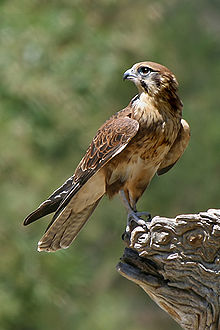
| |
| Brown falcon (Falco berigora) in Victoria, Australia | |
| Scientific classification | |
| Domain: | Eukaryota |
| Kingdom: | Animalia |
| Phylum: | Chordata |
| Class: | Aves |
| Order: | Falconiformes |
| Family: | Falconidae |
| Subfamily: | Falconinae |
| Genus: | Falco Linnaeus, 1758 |
| Type species | |
| Falco subbuteo Linnaeus, 1758 | |
| Species | |
|
38; see text. | |
| Synonyms | |
| |
Falcons (/ˈfɒlkən, ˈfɔːl-, ˈfæl-/) are birds of prey in the genus Falco, which includes about 40 species. Some small species of falcons with long, narrow wings are called hobbies, and some that hover while hunting are called kestrels. Falcons are widely distributed on all continents of the world except Antarctica, though closely related raptors did occur there in the Eocene.
Adult falcons have thin, tapered wings, which enable them to fly at high speed and change direction rapidly. Fledgling falcons, in their first year of flying, have longer flight feathers, which make their configuration more like that of a general-purpose bird such as a broadwing. This makes flying easier while still learning the aerial skills required to be effective hunters like the adults.
The falcons are the largest genus in the Falconinae subfamily of Falconidae, which also includes two other subfamilies comprising caracaras and a few other species of "falcons". All these birds kill prey with their beaks, using a tomial "tooth" on the side of their beaks — unlike the hawks, eagles and other larger birds of prey from the unrelated family Accipitridae, who use talons on their feet.
The largest falcon is the gyrfalcon at up to 65 cm (26 in) in length. The smallest falcon species is the pygmy falcon, which measures just 20 cm (7.9 in). As with hawks and owls, falcons exhibit sexual dimorphism, with the females typically larger than the males, thus allowing a wider range of prey species.
As is the case with many birds of prey, falcons have exceptional powers of vision; the visual acuity of one species has been measured at 2.6 times that of human eyes. They are incredibly fast fliers, with the Peregrine falcons having been recorded diving at speeds of 320 km/h (200 mph), making them the fastest-moving creatures on Earth; the fastest recorded dive attained a vertical speed of 390 km/h (240 mph).
Taxonomy
The genus Falco was introduced in 1758 by the Swedish naturalist Carl Linnaeus in the tenth edition of his Systema Naturae. The type species is the merlin (Falco columbarius). The genus name Falco is Late Latin meaning a "falcon" from falx, falcis, meaning "a sickle", referring to the claws of the bird. In Middle English and Old French, the title faucon refers generically to several captive raptor species.
The traditional term for a male falcon is tercel (British spelling) or tiercel (American spelling), from the Latin tertius (third) because of the belief that only one in three eggs hatched a male bird. Some sources give the etymology as deriving from the fact that a male falcon is about one-third smaller than a female (Old French: tiercelet). A falcon chick, especially one reared for falconry, still in its downy stage, is known as an eyas (sometimes spelled eyass). The word arose by mistaken division of Old French un niais, from Latin presumed nidiscus (nestling) from nidus (nest). The technique of hunting with trained captive birds of prey is known as falconry.
Compared to other birds of prey, the fossil record of the falcons is not well distributed in time. For years, the oldest fossils tentatively assigned to this genus were from the Late Miocene, less than 10 million years ago. This coincides with a period in which many modern genera of birds became recognizable in the fossil record. As of 2021, the oldest falconid fossil is estimated to be 55 million years old. Given the distribution of fossil and living Falco taxa, falcons are probably of North American, African, or possibly Middle Eastern or European origin. Falcons are not closely related to other birds of prey, and their nearest relatives are parrots and songbirds.
Overview
Falcons are roughly divisible into three or four groups. The first contains the kestrels (probably excepting the American kestrel); usually small and stocky falcons of mainly brown upperside colour and sometimes sexually dimorphic; three African species that are generally gray in colour stand apart from the typical members of this group. The fox and greater kestrels can be told apart at first glance by their tail colours, but not by much else; they might be very close relatives and are probably much closer to each other than the lesser and common kestrels. Kestrels feed chiefly on terrestrial vertebrates and invertebrates of appropriate size, such as rodents, reptiles, or insects.
The second group contains slightly larger (on average) species, the hobbies and relatives. These birds are characterized by considerable amounts of dark slate-gray in their plumage; their malar areas are nearly always black. They feed mainly on smaller birds.
Third are the peregrine falcon and its relatives, variably sized powerful birds that also have a black malar area (except some very light color morphs), and often a black cap, as well. They are very fast birds with a maximum speed of 390 kilometres per hour. Otherwise, they are somewhat intermediate between the other groups, being chiefly medium grey with some lighter or brownish colours on their upper sides. They are, on average, more delicately patterned than the hobbies and, if the hierofalcons are excluded (see below), this group typically contains species with horizontal barring on their undersides. As opposed to the other groups, where tail colour varies much in general but little according to evolutionary relatedness, the tails of the large falcons are quite uniformly dark grey with inconspicuous black banding and small, white tips, though this is probably plesiomorphic. These large Falco species feed on mid-sized birds and terrestrial vertebrates.
Very similar to these, and sometimes included therein, are the four or so species of hierofalcon (literally, "hawk-falcons"). They represent taxa with, usually, more phaeomelanins, which impart reddish or brown colors, and generally more strongly patterned plumage reminiscent of hawks. Their undersides have a lengthwise pattern of blotches, lines, or arrowhead marks.
While these three or four groups, loosely circumscribed, are an informal arrangement, they probably contain several distinct clades in their entirety.
A study of mtDNA cytochrome b sequence data of some kestrels identified a clade containing the common kestrel and related "malar-striped" species, to the exclusion of such taxa as the greater kestrel (which lacks a malar stripe), the lesser kestrel (which is very similar to the common, but also has no malar stripe), and the American kestrel, which has a malar stripe, but its colour pattern – apart from the brownish back – and also the black feathers behind the ear, which never occur in the true kestrels, are more reminiscent of some hobbies. The malar-striped kestrels apparently split from their relatives in the Gelasian, roughly 2.0–2.5 million years ago (Mya), and are seemingly of tropical East African origin. The entire "true kestrel" group—excluding the American species—is probably a distinct and quite young clade, as also suggested by their numerous apomorphies.
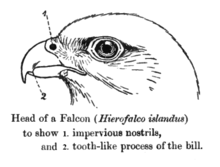
Other studies have confirmed that the hierofalcon are a monophyletic group–and that hybridization is quite frequent at least in the larger falcon species. Initial studies of mtDNA cytochrome b sequence data suggested that the hierofalcon are basal among living falcons. The discovery of a NUMT proved this earlier theory erroneous. In reality, the hierofalcon are a rather young group, originating at the same time as the start of the main kestrel radiation, about 2 Mya. Very little fossil history exists for this lineage. However, the present diversity of very recent origin suggests that this lineage may have nearly gone extinct in the recent past.
The phylogeny and delimitations of the peregrine and hobby groups are more problematic. Molecular studies have only been conducted on a few species, and the morphologically ambiguous taxa have often been little researched. The morphology of the syrinx, which contributes well to resolving the overall phylogeny of the Falconidae, is not very informative in the present genus. Nonetheless, a core group containing the peregrine and Barbary falcons, which, in turn, group with the hierofalcon and the more distant prairie falcon (which was sometimes placed with the hierofalcon, though it is entirely distinct biogeographically), as well as at least most of the "typical" hobbies, are confirmed to be monophyletic as suspected.
Given that the American Falco species of today belong to the peregrine group, or are apparently more basal species, the initially most successful evolutionary radiation seemingly was a Holarctic one that originated possibly around central Eurasia or in (northern) Africa. One or several lineages were present in North America by the Early Pliocene at latest.
The origin of today's major Falco groups—the "typical" hobbies and kestrels, for example, or the peregrine-hierofalcon complex, or the aplomado falcon lineage—can be quite confidently placed from the Miocene-Pliocene boundary through the Zanclean and Piacenzian and just into the Gelasian, that is from 2.4 to 5.3 Mya, when the malar-striped kestrels diversified. Some groups of falcons, such as the hierofalcon complex and the peregrine-Barbary superspecies, have only evolved in more recent times; the species of the former seem to be 120,000 years old or so.
Species
The sequence follows the taxonomic order of White et al. (1996), except for adjustments in the kestrel sequence.
| Image | Common name | Scientific name | Distribution |
|---|---|---|---|
 |
Malagasy kestrel | Falco newtoni | Madagascar, Mayotte, and the Comores. |
 |
Seychelles kestrel | Falco araeus | Seychelles Islands |
 |
Mauritius kestrel | Falco punctatus | Mauritius |
 |
Spotted kestrel | Falco moluccensis | Wallacea and Java. |
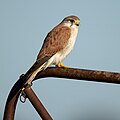 |
Nankeen kestrel or Australian kestrel | Falco cenchroides | Australia and New Guinea. |
 |
Common kestrel | Falco tinnunculus | Widespread in Europe, Asia, and Africa, as well as occasionally reaching the east coast of North America. |
 |
Rock kestrel | Falco rupicolus | Northwestern Angola and southern Democratic Republic of Congo to southern Tanzania, and south to South Africa. |
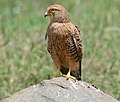 |
Greater kestrel | Falco rupicoloides | Namibia, Botswana, Zimbabwe, parts of Angola and Zambia and in much of South Africa. |
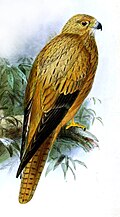 |
Fox kestrel | Falco alopex | South of the Sahara from Mali eastwards as far as Ethiopia and north-west Kenya. It occasionally wanders west to Senegal, the Gambia and Guinea and south to the Democratic Republic of the Congo. |
 |
Lesser kestrel | Falco naumanni | Mediterranean across Central Asia into China and Mongolia. |
 |
Grey kestrel | Falco ardosiaceus | Ethiopia, western parts of Kenya and Tanzania. |
 |
Dickinson's kestrel | Falco dickinsoni | Mozambique, Zimbabwe, Zambia and Malawi along with north-eastern South Africa. |
 |
Banded kestrel | Falco zoniventris | Madagascar |
 |
Red-necked falcon | Falco chicquera | Africa, India |
 |
Red-footed falcon | Falco vespertinus | Russia, Ukraine and bordering regions. |
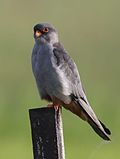 |
Amur falcon | Falco amurensis | South-eastern Siberia and Northern China. |
 |
Eleonora's falcon | Falco eleonorae | Greece, Cyprus, the Canary Islands, Ibiza and off Spain, Italy, Croatia, Morocco and Algeria. |
 |
Sooty falcon | Falco concolor | Northeastern Africa to the southern Persian Gulf region. |
 |
American kestrel or "sparrow hawk" | Falco sparverius | Central and western Alaska across northern Canada to Nova Scotia, and south throughout North America, into central Mexico and the Caribbean. |
 |
Aplomado falcon | Falco femoralis | Northern Mexico and Trinidad locally to southern South America. |
 |
Merlin or "pigeon hawk" | Falco columbarius | Eurasia, North Africa, North America. |
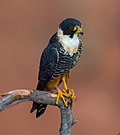 |
Bat falcon | Falco rufigularis | Tropical Mexico, Central and South America, and Trinidad |
 |
Orange-breasted falcon | Falco deiroleucus | Southern Mexico to northern Argentina. |
 |
Eurasian hobby | Falco subbuteo | Africa, Europe and Asia. |
 |
African hobby | Falco cuvierii | Angola, Benin, Botswana, Burkina Faso, Burundi, Cameroon, Central African Republic, Chad, Republic of the Congo, Democratic Republic of the Congo, Ivory Coast, Eswatini, Ethiopia, Gabon, Gambia, Ghana, Guinea, Guinea-Bissau, Kenya, Liberia, Malawi, Mali, Mozambique, Namibia, Niger, Nigeria, Rwanda, Senegal, Sierra Leone, Somalia, South Africa, Sudan, Tanzania, Togo, Uganda, Zambia, and Zimbabwe. |
 |
Oriental hobby | Falco severus | Eastern Himalayas and ranges southwards through Indochina to Australasia |
 |
Australian hobby or little falcon | Falco longipennis | Australia |
 |
New Zealand falcon or kārearea | Falco novaeseelandiae | New Zealand |
 |
Brown falcon | Falco berigora | Australia and New Guinea. |
 |
Grey falcon | Falco hypoleucos | Australia |
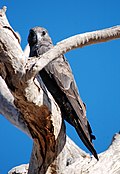 |
Black falcon | Falco subniger | Australia |
 |
Lanner falcon | Falco biarmicus | Africa, southeast Europe and just into Asia. |
 |
Laggar falcon | Falco jugger | Southeastern Iran, southeastern Afghanistan, Pakistan, through India, Nepal, Bhutan, Bangladesh and northwestern Myanmar. |
 |
Saker falcon | Falco cherrug | Eastern Europe, the Middle East, Central Asia and China. |
 |
Gyrfalcon | Falco rusticolus | Eastern and western Greenland, Canada, Alaska, Iceland and Norway. |
 |
Prairie falcon | Falco mexicanus | Western North America. |
 |
Peregrine falcon | Falco peregrinus | Cosmopolitan |
 |
Taita falcon | Falco fasciinucha | Kenya |
Extinct species
- Réunion kestrel, Falco duboisi – extinct (about 1700)
Fossil record
- Falco medius (Late Miocene of Cherevichnyi, Ukraine)
- ?Falco sp. (Late Miocene of Idaho)
- Falco sp. (Early Pliocene of Kansas)
- Falco sp. (Early Pliocene of Bulgaria – Early Pleistocene of Spain and Czech Republic)
- Falco oregonus (Early/Middle Pliocene of Fossil Lake, Oregon) – possibly not distinct from a living species
- Falco umanskajae (Late Pliocene of Kryzhanovka, Ukraine) – includes "Falco odessanus", a nomen nudum
- ?Falco bakalovi (Late Pliocene of Varshets, Bulgaria)
- Falco antiquus (Middle Pleistocene of Noailles, France and possibly Horvőlgy, Hungary)
- Cuban kestrel, Falco kurochkini (Late Pleistocene/Holocene of Cuba, West Indies)
- Falco chowi (China)
- Falco bulgaricus (Late Miocene of Hadzhidimovo, Bulgaria)
Several more paleosubspecies of extant species also been described; see species accounts for these.
"Sushkinia" pliocaena from the Early Pliocene of Pavlodar (Kazakhstan) appears to be a falcon of some sort. It might belong in this genus or a closely related one. In any case, the genus name Sushkinia is invalid for this animal because it had already been allocated to a prehistoric dragonfly relative. In 2015 the bird genus was renamed Psushkinia.
The supposed "Falco" pisanus was actually a pigeon of the genus Columba, possibly the same as Columba omnisanctorum, which, in that case, would adopt the older species name of the "falcon". The Eocene fossil "Falco" falconellus (or "F." falconella) from Wyoming is a bird of uncertain affiliations, maybe a falconid, maybe not; it certainly does not belong in this genus. "Falco" readei is now considered a paleosubspecies of the yellow-headed caracara (Milvago chimachima).
See also
- Abu Dhabi Falcon Hospital
- Falconry
- Ra
- Horus
- Khonsu
- National symbols of Kuwait
- National symbols of Saudi Arabia
Notes
- For example, tail colour in the common and lesser kestrels is absolutely identical, yet they do not seem closely related.
- IZAN 45-4033: left carpometacarpus. Small species; possibly closer to kestrels than to peregrine lineage or hierofalcons, but may be more basal altogether due to its age
- IMNH 27937. A coracoid of a merlin-sized species. It does not seem close to F. columbarius or the Recent North American species (Becker 1987).
- A hierofalcon (Mlíkovský 2002)? If so, probably not close to the living species, but an earlier divergence that left no descendants; might be more than one species due to large range in time and/or include common ancestor of hierofalcons and peregrine-Barbary complex (Nittinger et al. 2005).
- Supposedly a saker falcon paleosubspecies (Mlíkovský 2002), but this is not too likely due to the probable Eemian origin of that species.
References
- "Falconidae". aviansystematics.org. The Trust for Avian Systematics. Retrieved 25 July 2023.
- Strickland, H.E. (February 1841). "XLVIII. Commentary on Mr. G R. Gray's 'Genera of Birds.' 8vo. London, 1840". The Annals and Magazine of Natural History. Series 1. 6 (39): 416. hdl:2027/nnc1.1001656368. Retrieved 8 February 2024 – via HathiTrust.
- "Hieracidea Strickland, 1841". WoRMS - World Register of Marine Species. 26 April 2021. Archived from the original on 2 January 2022. Retrieved 8 February 2024.
- "FALNOV.pdf" (PDF). New Zealand Birds Online (published 3 September 2020). 6 March 2013. Archived (PDF) from the original on 8 February 2024. Retrieved 8 February 2024. (Text extracted from Gill, B.J.; Bell, B.D.; Chambers, G.K.; Medway, D.G.; Palma, R.L.; Scofield, R.P.; Tennyson, A.J.D.; Worthy, T.H. (2010). Checklist of the birds of New Zealand, Norfolk and Macquarie Islands, and the Ross Dependency, Antarctica (4th ed.). Wellington, Te Papa Press and Ornithological Society of New Zealand. pp. 174–176.)
- Friedmann, Herbert (1950). The birds of North and Middle America: a descriptive catalog of the higher groups, genera, species, and subspecies of birds known to occur in North America, ... Smithsonian Institution United States National Museum Bulletin, no. 50, part 11. United States Government Printing Office. p. 615. hdl:2027/osu.32435029597671. Retrieved 9 February 2024 – via HathiTrust.
- Richmond, Charles W. (1902). List of generic terms proposed for birds during the years 1890 to 1900, inclusive, to which are added names omitted by Waterhouse in his "Index generum avium," ... Proceedings of the United States National Museum. Vol. 24. Washington: Smithsonian Institution / Government Printing Office. p. 685. hdl:2027/coo.31924090189725. Retrieved 9 February 2024 – via HathiTrust.
- ^ Oberprieler, Ulrich; Cillié, Burger (2009). The raptor guide of Southern Africa. Game Parks Publishing. ISBN 9780620432238.
- Sale, Richard (28 July 2016). Falcons (Collins New Naturalist Library, Book 132). HarperCollins UK. ISBN 9780007511433.
- Cenizo, Marcos; Noriega, Jorge I.; Reguero, Marcelo A. (2016). "A stem falconid bird from the Lower Eocene of Antarctica and the early southern radiation of the falcons". Journal of Ornithology. 157 (3): 885. Bibcode:2016JOrni.157..885C. doi:10.1007/s10336-015-1316-0. hdl:11336/54190. S2CID 15517037.
- Krüger, Oliver (2005). "The Evolution of Reversed Sexual Dimorphism in Hawks, Falcons and Owls: a comparative study". Evolutionary Ecology. 19 (5): 467–486. doi:10.1007/s10682-005-0293-9. S2CID 22181702.
- Fox, R; Lehmkuhle, S.; Westendorf, D. (1976). "Falcon visual acuity". Science. 192 (4236): 263–65. Bibcode:1976Sci...192..263F. doi:10.1126/science.1257767. PMID 1257767.
- "The Speed of Animals" in The New Book of Knowledge. Grolier Academic Reference. 2003. p. 278. ISBN 071720538X
- Linnaeus, Carl (1758). Systema Naturae per regna tria naturae, secundum classes, ordines, genera, species, cum characteribus, differentiis, synonymis, locis (in Latin). Vol. 1 (10th ed.). Holmiae (Stockholm): Laurentii Salvii. p. 88.
- Dickinson, E.C.; Remsen, J.V. Jr., eds. (2013). The Howard & Moore Complete Checklist of the Birds of the World. Vol. 1: Non-passerines (4th ed.). Eastbourne, UK: Aves Press. p. 349. ISBN 978-0-9568611-0-8.
- Jobling, James A. (2010). The Helm Dictionary of Scientific Bird Names. London: Christopher Helm. p. 63. ISBN 978-1-4081-2501-4.
- Stevenson, Angus; Brown, Lesley, eds. (2007). Shorter Oxford English dictionary on historical principles (6th. ed.). Oxford: Oxford University Press. ISBN 9780199206872. OCLC 170973920.
- ^ Groombridge, Jim J.; Jones, Carl G.; Bayes, Michelle K.; van Zyl, Anthony J.; Carrillo, José; Nichols, Richard A.; Bruford, Michael W. (2002). "A molecular phylogeny of African kestrels with reference to divergence across the Indian Ocean". Molecular Phylogenetics and Evolution. 25 (2): 267–77. Bibcode:2002MolPE..25..267G. doi:10.1016/S1055-7903(02)00254-3. PMID 12414309.
- Harper, Douglas. "tercel". Online Etymology Dictionary.
- "tercel". Dictionary.reference.com. Retrieved 20 March 2010.
- "tercel", Oxford Dictionary
- "eyas". Thefreedictionary.com. Retrieved 20 March 2010.
- "Dictionary of Difficult Words – eyas". Tiscali.co.uk. 21 September 1964. Archived from the original on 5 January 2009. Retrieved 20 March 2010.
- Li, Zhiheng; Zhou, Zhonghe; Deng, Tao; Li, Qiang; Clarke, Julia A. (4 June 2014). "A falconid from the Late Miocene of northwestern China yields further evidence of transition in Late Neogene steppe communities". The Auk: Ornithological Advances. 131: 335–350.
- Mayr, Gerald; Kitchener, Andrew C. (1 October 2021). "New fossils from the London Clay show that the Eocene Masillaraptoridae are stem group representatives of falcons (Aves, Falconiformes)". Journal of Vertebrate Paleontology. 41 (6). Bibcode:2021JVPal..41E3515M. doi:10.1080/02724634.2021.2083515. ISSN 0272-4634.
- Kirschbaum, Kari. "Falconidae (falcons)". Animal Diversity Web. Retrieved 1 May 2024.
- Suh A, Paus M, Kiefmann M, et al. (2011). "Mesozoic retroposons reveal parrots as the closest living relatives of passerine birds". Nature Communications. 2 (8): 443–8. Bibcode:2011NatCo...2..443S. doi:10.1038/ncomms1448. PMC 3265382. PMID 21863010.
- ^ Helbig, A.J.; Seibold, I.; Bednarek, W.; Brüning, H.; Gaucher, P.; Ristow, D.; Scharlau, W.; Schmidl, D. & Wink, Michael (1994): Phylogenetic relationships among falcon species (genus Falco) according to DNA sequence variation of the cytochrome b gene. In: Meyburg, B.-U. & Chancellor, R.D. (eds.): Raptor conservation today: pp. 593–99
- ^ Wink, Michael; Seibold, I.; Lotfikhah, F. & Bednarek, W. (1998): Molecular systematics of holarctic raptors (Order Falconiformes). In: Chancellor, R.D., Meyburg, B.-U. & Ferrero, J.J. (eds.): Holarctic Birds of Prey: 29–48. Adenex & WWGBP
- ^ Wink, Michael & Sauer-Gürth, Hedi (2000): Advances in the molecular systematics of African raptors. In: Chancellor, R.D. & Meyburg, B.-U. (eds): Raptors at Risk: 135–47. WWGBP/Hancock House, Berlin/Blaine.
- Wink, Michael; Sauer-Gürth, Hedi; Ellis, David & Kenward, Robert (2004): Phylogenetic relationships in the Hierofalco complex (Saker-, Gyr-, Lanner-, Laggar Falcon). In: Chancellor, R.D. & Meyburg, B.-U. (eds.): Raptors Worldwide: 499–504. WWGBP, Berlin
- ^ Nittinger, F.; Haring, E.; Pinsker, W.; Wink, Michael; Gamauf, A. (2005). "Out of Africa? Phylogenetic relationships between Falco biarmicus and other hierofalcons (Aves Falconidae)" (PDF). Journal of Zoological Systematics and Evolutionary Research. 43 (4): 321–31. doi:10.1111/j.1439-0469.2005.00326.x.
- Johnson, J.A.; Burnham, K.K.; Burnham, W.A.; Mindell, D.P. (2007). "Genetic structure among continental and island populations of gyrfalcons" (PDF). Molecular Ecology. 16 (15): 3145–60. Bibcode:2007MolEc..16.3145J. doi:10.1111/j.1365-294X.2007.03373.x. hdl:2027.42/71471. PMID 17651193. S2CID 17437176.
- Griffiths, Carole S. (1999). "Phylogeny of the Falconidae inferred from molecular and morphological data" (PDF). Auk. 116 (1): 116–30. doi:10.2307/4089459. JSTOR 4089459.
- Griffiths, Carole S.; Barrowclough, George F.; Groth, Jeff G.; Mertz, Lisa (2004). "Phylogeny of the Falconidae (Aves): a comparison of the efficacy of morphological, mitochondrial, and nuclear data". Molecular Phylogenetics and Evolution. 32 (1): 101–09. Bibcode:2004MolPE..32..101G. doi:10.1016/j.ympev.2003.11.019. PMID 15186800.
- White, Clayton M.; Olsen, Penny D. & Kiff, Lloyd F. (1994): Family Falconidae. In: del Hoyo, Josep; Elliott, Andrew & Sargatal, Jordi (editors): Handbook of Birds of the World, Volume 2 (New World Vultures to Guineafowl): 216–75, plates 24–28. Lynx Edicions, Barcelona. ISBN 84-87334-15-6
- ^ Becker, Jonathan J. (1987). "Revision of "Falco" ramenta Wetmore and the Neogene evolution of the Falconidae" (PDF). Auk. 104 (2): 270–76. doi:10.1093/auk/104.2.270. JSTOR 4087033.
- ^ Mlíkovský, Jirí (2002): Cenozoic Birds of the World, Part 1: Europe Archived 20 May 2011 at the Wayback Machine. Ninox Press, Prague
- Fox Canyon Local Fauna, 4.3–4.8 million years ago: Martin, R.A.; Honey, J.G. & Pelaez-Campomanes, P. (2000): The Meade Basin Rodent Project; a progress report. Kansas Geological Survey Open-file Report 2000-61. Paludicola 3(1): 1–32.
- UMMP V27159, V29107, V57508-V57510, V57513/V57514 some limb bones. Slightly smaller than a merlin and more robust than American kestrel, and seems not too distant from F. columbarius. Feduccia, J. Alan; Ford, Norman L. (1970). "Some birds of prey from the Upper Pliocene of Kansas" (PDF). Auk. 87 (4): 795–97. doi:10.2307/4083714. JSTOR 4083714.
- NNPM NAN 41-646. Almost complete left tarsometatarsus. Probably a prehistoric hobby, perhaps less specialized for bird hunting: Sobolev, D.V. (2003): Новый вид плиоценового сокола (Falconiformes, Falconidae) Vestnik zoologii 37 (6): 85–87.
- Boev, Z. 1999. Falco bakalovi sp. n. – a Late Pliocene falcon (Falconidae, Aves) from Varshets (W Bulgaria). – Geologica Balcanica, 29 (1–2): 131–35.
- Boev, Z. 2011. New fossil record of the Late Pliocene kestrel (Falco bakalovi Boev, 1999) from the type locality in Bulgaria. – Geologica Balcanica, 40 (1–3): 13–30.
- Boev, Z. 2011. Falco bulgaricus sp. n. (Aves, Falconiformes) from the Middle Miocene of Hadzhidimovo (SW Bulgaria). – Acta zoologica bulgarica, 63 (1): 17–35.
- Nikita V. Zelenkov; Evgeny N. Kurochkin (2015). "КЛАСС AVES". In E.N. Kurochkin; A.V. Lopatin; N.V. Zelenkov. Ископаемые позвоночные России и сопредельных стран. Ископаемые рептилии и птицы. Часть 3 / Fossil vertebrates of Russia and adjacent countries. Fossil Reptiles and Birds. Part 3. GEOS. pp. 86–290. ISBN 978-5-89118-699-6.
Further reading
- Fuchs, J.; Johnson, J.A.; Mindell, D.P. (2015). "Rapid diversification of falcons (Aves: Falconidae) due to expansion of open habitats in the Late Miocene". Molecular Phylogenetics and Evolution. 82: 166–182. Bibcode:2015MolPE..82..166F. doi:10.1016/j.ympev.2014.08.010. PMID 25256056.
External links
- Falconidae videos on the Internet Bird Collection, ibc.lynxeds.com
- The Raptor Resource Project – Peregrine, owl, eagle and osprey cams, facts, and other resources, raptorresource.org
- "Falcon" . New International Encyclopedia. 1905.
| Genera of falcons and their extinct allies | |||||||||||||||||||
|---|---|---|---|---|---|---|---|---|---|---|---|---|---|---|---|---|---|---|---|
| |||||||||||||||||||
| |||||||||||||||||||